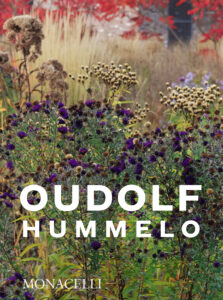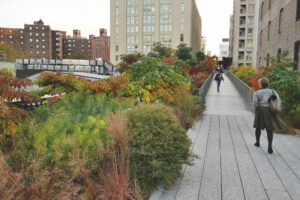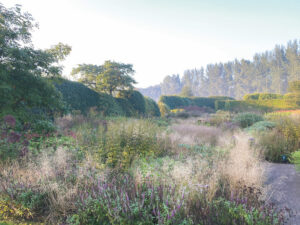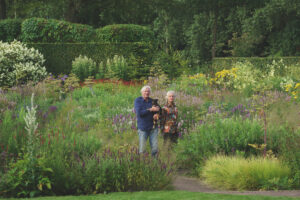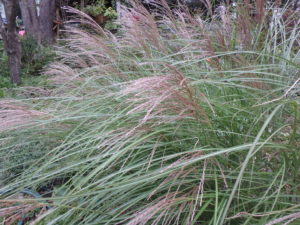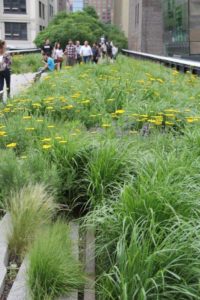Learning from a Good Book
At over 400 pages it might seem daunting, but I’d estimate that nearly half of those pages are color photos of the gardens Piet Oudlof designed, with plenty from his home in Hummelo, Holland. It is written by Noel Kingsbury, a well-known British garden writer, and by Oudlof himself.
So what makes Piet Oudolf one of the most famous garden designers ever? First, he is a highly accomplished plantsman. When he specifies plants for a garden, he knows what they need to do well. He started out with his wife, Anja, growing most of the plants he used in his designs, often growing and selecting plants for years before using them.
Piet Oudolf uses many tall grasses in his designs. He loves the way they provide structure and form to a design, and that they last well into winter. He is less interested in color than many designers. He loves the look of seed heads and stems after the (relatively short) bloom period is over. He is quoted in the book as saying, “A plant is only worth growing if it also looks good when it is dead.” Since he bred plants for toughness, I assume he means dormant, not dead.
Early on in his career, Piet Oudolf used large blocks of a single species of a plant. But as he refined his designs, he started intermingling a few large, tall plants inside a block. He planted them repeatedly, as repetition adds a sense of unity and coherence to a garden. Unlike many designers, he actually lays out his gardens himself instead of drawing a plan and handing it off to gardeners. Oudolf is first and foremost a gardener. He loves plants, and knows them like his ever-present dogs.
Tips for Good Garden Design from Piet Oudolf
I was out in my garden recently and noticed that my tall decorative grasses are looking quite bedraggled. I have a clump of fountain grass (Miscanthus sinensis) a variety called ‘Morning Light’. It’s time to cut back all the stems and flowers that stood up, largely, to the winter winds.
Looking at it made me think of Piet (pronounced Pete) Oudolf, a Dutch garden designer who works all over the world. Oudolf loves decorative grasses and uses them often, including in the High Line Gardens that he designed in New York. I had a chance to meet him and tour his personal gardens outside of Amsterdam in 2007, and I recently re-visited my notes from that time.
Piet Oudolf primarily designs gardens on a grand scale. The High Line project in New York City transformed a mile and a half of abandoned elevated railway into a garden. He is the designer of the memorial gardens just blocks away from the former site of the World Trade Center in Battery Park at the tip of New York, at The Gardens of Remembrance. He has done gardens in Chicago and Stockholm and elsewhere. He is the author of several books, including “Planting Design: Gardens in Time and Space.”
I visited him at his home in Humelo, Holland and we talked about gardening. Asked about his philosophy of gardening, Oudolf told me that he doesn’t have one, but, he said, “I know what I like.” Early on, he said had felt trapped by English gardening –“I’m not a color gardener” – and he tried to find a way to escape. Tall decorative grasses and prairie plants appealed to him. We walked through his personal gardens, and his love of plants that provide winter interest was obvious.
Oudolf has a couple of acres of gardens surrounding his house. I visited in January, a time when only a few early hellebores were blooming. I noticed that he used sharply clipped evergreen hedges as counterpoints to the tall grasses that waved in the wind, and to the array of summer plants that had been left to show off their seedpods during the winter. I wondered aloud what he would do in an urban setting, say something 30 meters (100 ft) square.
First, he said you need to plan a space that is comfortable year round – some place where you’d like to spend time. Start by taking up most of the sod, and getting a soil test done before doing any planting. Amend the soil with compost and minerals as needed. Select easy-to-care for plants, things that are tolerant of a variety of conditions. It’s important, he noted, that you choose plants that need the same basic conditions if they are to grow together and do well. So, for example, don’t try to plant heather (which needs acidic soil) right next to lavender (that needs slightly sweet soil).
Oudolf believes in mass plantings, not a hodge-podge of individual plants of many different species. He pointed out that you also need to have an array of plants that bloom in different seasons. He suggests 30% spring plants, 40-45% summer bloomers, and 25% plants that are best in autumn. And he believes in cleaning the garden in late winter or early spring so that those tall grasses and perennials will be interesting all winter long.
It is important to separate your garden space from that of your neighbors, according to Oudolf, either by planting a woody hedge or by building a fence. He likes iron fences that can be used as support for climbing plants like clematis, or be used to train woody plants into shaded tunnels. In his own gardens he created raised beds to change the level of the flat garden, building 30 inch tall brick circles filled with soil and planted with tall decorative grasses.
Pathways are important for gardens, Oudolf explained, as they lead the viewer through the garden. He believes that you shouldn’t be able to see the entire garden at once. You can create tension by placing tall plants and hedges in the front of a garden, he said. He likes hard surfaces for walkways in small gardens, either stone or brick, but grass as the path in larger gardens. Obviously in public gardens he uses concrete or stone to keep the foot traffic from wearing down the grass.
Places to sit should be included whether in a public or private garden, Oudolf said. His own gardens have benches for relaxing, though I suspect he has little time to use them. One of my favorite features in his garden were the sheep. No, not live sheep. He has a sense of humor, and has nice carved marble sheep resting on the lawn. Unfortunately my photos have all disappeared.
I have been to the High Line Gardens a couple of times, and they are definitely worth a visit. I understand they are now one of the most-visited tourist attractions in New York City. Meander along the path and you will see how Piet Oudolf incorporates all the design principles mentioned above. Go see the High Line, and then incorporate some of his ideas in your own gardens.
Henry Homeyer can be reached at henry.homeyer@comcast.net or P.O. Box 364, Cornish Flat, NH 03746. Please include a SASE if requesting a mailed response.



